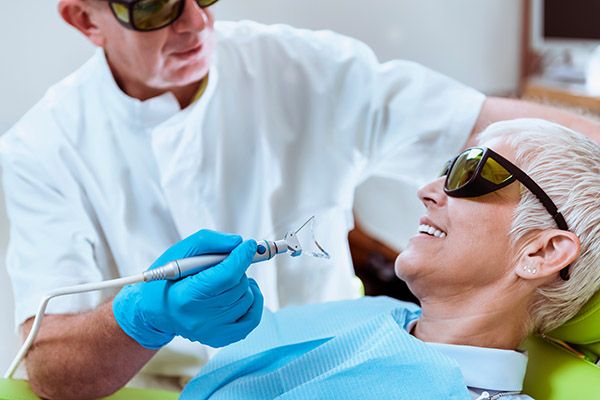 Laser teeth whitening is performed in a dentist's office and uses a peroxide gel combined with laser light to speed up the whitening action of the gel. Although home whitening kits are available, the American Dental Association recommends a thorough evaluation by a dental professional to determine the cause of teeth discoloration and recommend the proper treatment plan.
Laser teeth whitening is performed in a dentist's office and uses a peroxide gel combined with laser light to speed up the whitening action of the gel. Although home whitening kits are available, the American Dental Association recommends a thorough evaluation by a dental professional to determine the cause of teeth discoloration and recommend the proper treatment plan.
The basics of teeth whitening
Having whiter teeth can help a person feel more comfortable with their smile. Laser teeth whitening is a safe and effective procedure that can boost confidence and enhance the quality of life.
Why teeth become discolored
Eating and drinking things that can stain teeth is a common cause of discoloration. These types of stains on the outside of the enamel are called extrinsic discoloration. Coffee, tea, red wine, and berries can all contribute to changing tooth color. Tobacco use is also a major culprit.
Sometimes people's habits are not the cause of discolored teeth. Although the perception is that white teeth are normal, people are born with a wide variety of shades due to their genetics. This shading is deeper in the tooth surface and is called intrinsic discoloration. Aging, injury, and medications such as tetracycline can also cause intrinsic discoloration.
How whitening works
Teeth can be whitened by a polishing action, which is how whitening toothpaste works, or by a chemical reaction, which is the method used by home whitening kits or in-office whitening procedures. According to the ADA, not all discoloration responds to whitening techniques. Polishing is only effective on extrinsic discoloration, but peroxide-based chemicals can address extrinsic and some intrinsic discoloration.
Both home kits and in-office procedures use a peroxide gel applied to the teeth to lighten the color. With laser teeth whitening, after the gel is applied, a laser is directed at the teeth. The heat from the laser helps the gel penetrate into the teeth and also speeds up the chemical reaction that causes whitening. One laser whitening treatment may lighten teeth as much as five or six shades.
When to use laser teeth whitening
The ADA recommends having a dentist assess whether whitening is an appropriate treatment, as there are a few contraindications. Any gum disease or tooth decay should be addressed before beginning whitening. Dental materials such as crowns or fillings will not respond to whitening, so a patient may be surprised by uneven results from home whitening efforts.
Some people may experience minor side effects, such as teeth sensitivity to heat or cold, or slight irritation to the gums. When they occur, these symptoms should last only a couple of days. Overwhitening should be avoided as it can harm the enamel. A dentist can help determine how much whitening is necessary.
Improve your smile today
The practice of teeth whitening has been around for centuries, and according to the ADA, today's methods are fast, safe, and effective, as long as a dental professional is consulted to recommend the appropriate method of whitening. Laser teeth whitening can produce a naturally bright, white smile in just one hour, helping to improve a person's appearance and confidence.
Request an appointment or call Encino Cosmetic & Dental Implants at 818-578-2333 for an appointment in our Encino office.
Related Posts
A common cosmetic dental complaint is stained or discolored teeth. The good news is there are numerous options, including laser teeth whitening, that can brighten the teeth and improve the smile without using invasive procedures. Many people choose to get in-office teeth whitening because it tends to have better and longer-lasting results. However, dark-colored foods…
Laser teeth whitening puts gums and other soft tissues of the mouth at risk of irritation and injury. Sometimes, the whitening gel still touches the gums, and this can be a painful ordeal. Knowing this possible risk can help prepare you for your upcoming laser teeth whitening treatment. If you want to know more about…
Laser teeth whitening can remove the most stubborn stains and help dental patients smile confidently. The process has been a staple of cosmetic dentistry for many years, and most patients tolerate it well, with minimal discomfort. Under the auspices of the United States Department of Health and Human Services, the Food and Drug Administration approves…




